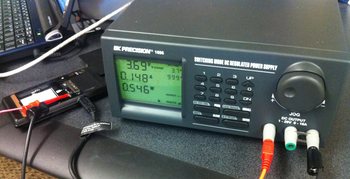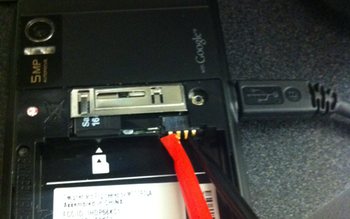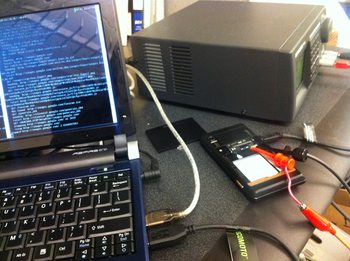For a recent research project, I measured the power consumption of a smartphone. Because their battery life is a critical design constraint, it’s import to understand how smartphones’ software behavior influences their power usage, but there aren’t many tools available for actually measuring power—especially ones that are remotely affordable. I’ve seen many papers that use expensive, special-purpose power measurement tools like the $771 one from Monsoon Solutions or cumbersome custom setups. Because I’m utterly clueless when it comes to electronics, I needed a straightforward apparatus that could be controlled mostly through software. This post describes a simple, relatively cheap setup I used to get some reasonable power measurements.
The Equipment

The only equipment I shelled out for in this setup was a DC power supply: specifically, the BK Precision 1696. At $375, this power supply has everything we need: a reasonable DC voltage and current range and, crucially, a serial port for communication with a computer that can do the measurement and control footwork. (I’m sure any similar equipment would work, but I’ve written some software that works with this supply in particular—see below.) Unless you have an ancient serial-port-equipped host machine, you’ll likely also want a USB serial interface like this one (a very affordable commodity part). The only other physical equipment necessary is a few wires of the sort easily found in an electrical-engineering lab on any university campus. (I cannot, of course, condone the “borrowing” of any such materials…)
The Setup

The next challenge is to get the smartphone to run off of the power supply so we can measure its energy consumption. The most straightforward way I found to do this was to replace the device’s battery with the power supply. This just involves removing the battery, finding the appropriate terminals, and wiring the supply’s output to them. In my case—I was measuring an original Motorola DROID—there were two extra pins for communication with the battery’s charge meter; the phone worked fine with these pins left disconnected from anything.
After looking up the battery’s voltage, I configured the power supply to that level in “constant voltage” mode and turned on the phone. Shockingly, this works! The DROID was slightly confused about its battery capacity level, but it operated normally.
To control the measurements, I used connected a host laptop via USB to both the phone (to control the software) and the power supply (to take measurements).
The Software

On the host machine, there are two main software components: one to talk to the smartphone and one that talks to the power supply. The former is pretty straightforward—I manage the “rooted” Android software via SSH (SSHDroid)—so I’ll just describe the power supply management here.
First, I needed a driver for the USB/serial adapter. Most Linux boxes probably have this installed; on Mac OS X, the osx-pl2303 project covers most devices.
I used a somewhat hard-to-find description of the BK Precision 1696’s serial protocol to build a Python library for communicating with the power supply. The library takes care of the command encoding, conversion between ordinary floating-point numbers and the protocol’s arcane fixed-point formats, and other mundanities. To get started, download the library and start coding:
import psup
with psup.Supply() as sup:
sup.voltage(1.3)
volts, amps = sup.reading()
print '%f V, %f A' % (volts, amps)
The Supply class represents a connection to the power supply. It’s also a
context manager, so if you wrap your code in a Python with statement,
the connection will be automatically opened and then cleaned up when you’re
done. Once you have a connection, you can call voltage to set the voltage,
reading to get the current sampled voltage and current, maxima to get the
acceptable parameter ranges, et cetera. I haven’t implemented the entire serial
protocol, but I found these commands to be enough to conduct reasonable
power-measurement experiments. If you want to add any functionality, please feel
free to fork the project on GitHub or send me patches.